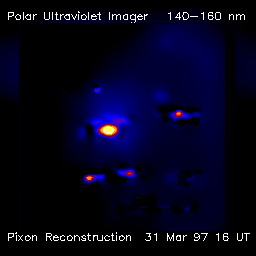into the Polar Satellite Field-of-View
|
The POLAR spacecraft, launched on February 24th, 1996,
is part of the International Solar-Terrestrial Physics (ISTP)
program - a powerful compliment of satellites, ground-based observatories
and theoretical investigations, aimed at studying the Sun-Earth
system in a global context. POLAR's primary mission is to study
the Earth's aurora, but recently it turned its electronic eyes
to the skies in order to view Hale-Bopp, the comet of the century.
POLAR is unique in its ability to image the comet near perihelion
(its closest approach to the Sun) and in a wide wavelength range
covering visible through X-ray. No other imaging system can
come anywhere near the 20o Sun constraint of POLAR,
not even NASA's Hubble Space Telescope. POLAR's payload includes
13 instruments. Among these are three imagers which are specialized
cameras with sensitivities in different wavelengths. The POLAR
imagers are located on a de-spun platform which has one degree
of freedom for motions to optimize auroral viewing. Comet Hale-Bopp
crossed the orbital plane of the POLAR spacecraft on April 1,
1997, and was within the field of view of the imagers over the
period from March 27th to April 2nd.
According to Dr. John Sigwarth, Visible Imaging System Instrument Scientist at the University
of Iowa, "We are extremely excited to have this unique opportunity to study
a once-in-a-lifetime comet". The POLAR comet watch was achieved using its three cameras - the Visible Imaging System (VIS), the Ultra-Violet Imager (UVI) and the Polar Ionospheric X-Ray Imaging Experiment (PIXIE). The VIS observed the comet with 1 far ultraviolet and 10 visible filters. Simultaneously, the UVI imaged with 4 filters sensitive in different bands of the far ultraviolet and the PIXIE obtained an upper limit on the X-ray flux from Hale-Bopp. |
Visible Imaging
|
Sodium Filter (wavelength = 589.0 nm)
This striking image of the comet clearly shows both the sodium and dust tails. In the image, the two tails extend beyond the field-of-view of the visible camera. Approximately 20 million km of the cometary tails can be seen. Relative to the image of the comet, the sun is located 40o down and 10o to the right of the nucleus, as denoted by the arrow. The force of the solar wind causes the sodium tail to be swept 7o clockwise from the anti-sunward direction. The dominant emission in the figure is sunlight scattered off neutral sodium, with lesser contribution from the continuum sunlight scattered by dust and NH2. This means that some of the dust grains which produce the dust tail (to the right and the wider of the two tails) are neutral sodium. The sodium tail, to the left, is a new discovery made independently by POLAR and also by the Isaac Newton Group in La Palma, Spain. POLAR press release |
|
OH Filter (wavelength = 308.5 nm)
The hydroxide radical, thought to be second only to atomic hydrogen in production rate in comets, is difficult to study from the ground because of atmospheric absorption at wavelengths shorter than 310 nm. However, the spectral emission of the OH radical at 308.5 nm is more intense than any other spectral feature. The POLAR Visible Imaging System obtained these unique observations of the cometary OH near perihelion. The extended coma around the central bright spot is about 3 million km in diameter - immense in comparison to the 40 km nucleus at the center. The size of the coma is governed by the rate of outflowing water from the comet and the lifetime of the OH in the interplanetary region . The OH production rate accounts for almost 90% of the water production rate in comets. The water itself is difficult to detect but when split into its components of hydrogen and hydroxide by the sun's ultraviolet rays, it is relatively easy to detect the OH radical and use it as a tracer for the amount of water thrown off by the comet. Hale-Bopp is currently estimated to be eroding at a rate of approximately 1cm every 6.5 hours. |
Ultraviolet Imaging
X-Ray Imaging
In addition to the Visible and UV wavelength imagers, the Polar
Ionospheric X-Ray Imaging Experiment (PIXIE) camera also viewed
Hale-Bopp. In the PIXIE X-ray range the comet was very dark. In fact, the
results suggest that PIXIE only observed the shadow cast by the comet against
the faint, diffuse X-ray background. No X-rays were observed coming from the
comet itself. In the X-ray
wavelength range, Hale-Bopp is no brighter than Hyakutake was expected to be,
based on the XTE observations and models for Hyakutake. The PIXIE results are
consistent with the predictions of comet experts who forecast that there would
be no X-ray emission lines in the PIXIE energy range.
Authors and curators:
- Nicky J. Fox, NASA/GSFC (301) 286-8872
- John B. Sigwarth, University of Iowa, (319-335-1867)
Official NASA Contact: Mr. William Mish (wmish@istp1.gsfc.nasa.gov)
/ NASA Home /
Goddard Space Flight Center Home
/
Last Updated: 04/18/97





